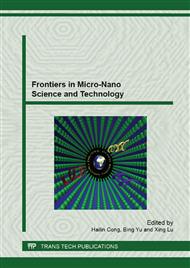[1]
D. F. Davidson, R. K. Hanson, High temperature reaction rate coefficients derived from N-atom ARAS measurements and excimer photolysis of NO, Int. J. Chem. Kinet. 22 (1990) 843-861.
DOI: 10.1002/kin.550220805
Google Scholar
[2]
M. Koshi, M. Yoshimura, K. Fukuda, etc. Reactions of N(4S) atoms with NO and H2 , J. Chem. Phys. 93 (1990) 8703-8708.
Google Scholar
[3]
Toshiyuki Takayanagi, Yuzuru Kurosaki, Keiichi Yokoyama. Ab initio molecular orbital calculations of potential energy surfaces for the N(4S, 2D, 2P)+H2 reactions. Chem. Phys. Lett. 321 (2000)106-112.
DOI: 10.1016/s0009-2614(00)00329-8
Google Scholar
[4]
Zhang Shao Wen, Thanh N. Truong. Direct ab initio dynamics studies of N+H2↔NH+H reaction, J. Chem. Phys. 113(2000)6149-6154.
DOI: 10.1063/1.1308544
Google Scholar
[5]
Ronald Z. Pascual, George C. Schatz, Gÿorgÿ Lendvay, etc. Quasiclassical trajectory and transition state theory studies of the N(4S)+H2↔NH(X3Σ-)+H reaction [J]. J. Chem. Phys.A. 106(2002) 4125-4136.
DOI: 10.1021/jp0133079
Google Scholar
[6]
L. A. Poveda, A. J. C. Varandas. Repulsive double many-body expansion potential energy surface for the reactions N(4S)+H2↔NH(X3Σ-)+H from accurate ab initio calculations, Phy. Chem. Chem. Phys. 7(2005)2867-2873.
DOI: 10.1039/b505590c
Google Scholar
[7]
Hans-Joachim Werner, Peter J. Knowles. An efficient internally contracted multiconfiguration -reference configuration interaction method, J. Chem Phys. 88(1988) 5803-5814.
DOI: 10.1063/1.455556
Google Scholar
[8]
Peter J. Knowles, Hans-Joachim Werner. An efficient method for the evaluation of coupling coefficients in configuration interaction calculations, Chem. Phys. Lett. 145(1988) 514-522.
DOI: 10.1016/0009-2614(88)87412-8
Google Scholar
[9]
A. J. C. Varandas. Intermolecular and intramolecular potentials: topographical aspects, calculation, and functional representation via a double many-body expansion method, Adv. Chem. Phys. 74(1988)255-338.
DOI: 10.1002/9780470141236.ch2
Google Scholar
[10]
Zhang Juan, Chu Tian Shu, Dong Shun Le, etc. Influence of isotope effects on the stereodynamics of the N(4S)+H2 →NH+H reactive system: a QCT study, Chin. Phys. Lett. 28(2011) 093403.
DOI: 10.1088/0256-307x/28/9/093403
Google Scholar
[11]
Han Boran, Yang Huan, Zheng Yujun, etc. Quasi-classical trajectory and quantum mechanics study of the reaction H(2S) + NH → N(4S) + H2, Chem. Phys. Lett. 493(2010) 225-228.
DOI: 10.1016/j.cplett.2010.05.049
Google Scholar
[12]
Yu Yong Jiang, Xu Qiang, Xu Xiu Wei. Influence of rotational excitation and collision energy on the stereo dynamics of the reaction: N(4S)+H2 (v= 0, j= 0, 2, 5, 10)→NH(X3Σ-)+H, Chin. Phys.B. 20( 2011)123402.
DOI: 10.1088/1674-1056/20/12/123402
Google Scholar
[13]
Yu Yong Jiang, Wang De Hua, Feng Shu Xiang, etc. Influence of vibrational excitation and collision energy on the stereo dynamics of the reactions: N(4S)+H2(v=0-3, j=0)→NH(X3Σ-)+H, J. Theor. Comput. Chem. 11(2012)763-780.
Google Scholar
[14]
Han Ke Li, He Guo Zhong, Lou Nan Quan. Effect of location of energy barrier on the product alignment of reaction A+BC, J. Chem. Phys. 105(1996) 8699-8704.
DOI: 10.1063/1.472651
Google Scholar
[15]
Han Boran, Zong Fu Jian, Wang Chun Lei, etc. Product polarization on the 3A" electronic state in the H+FO reaction and its isotope variant, Chem. Phys. 374(2010) 94-98.
DOI: 10.1016/j.chemphys.2010.06.028
Google Scholar


